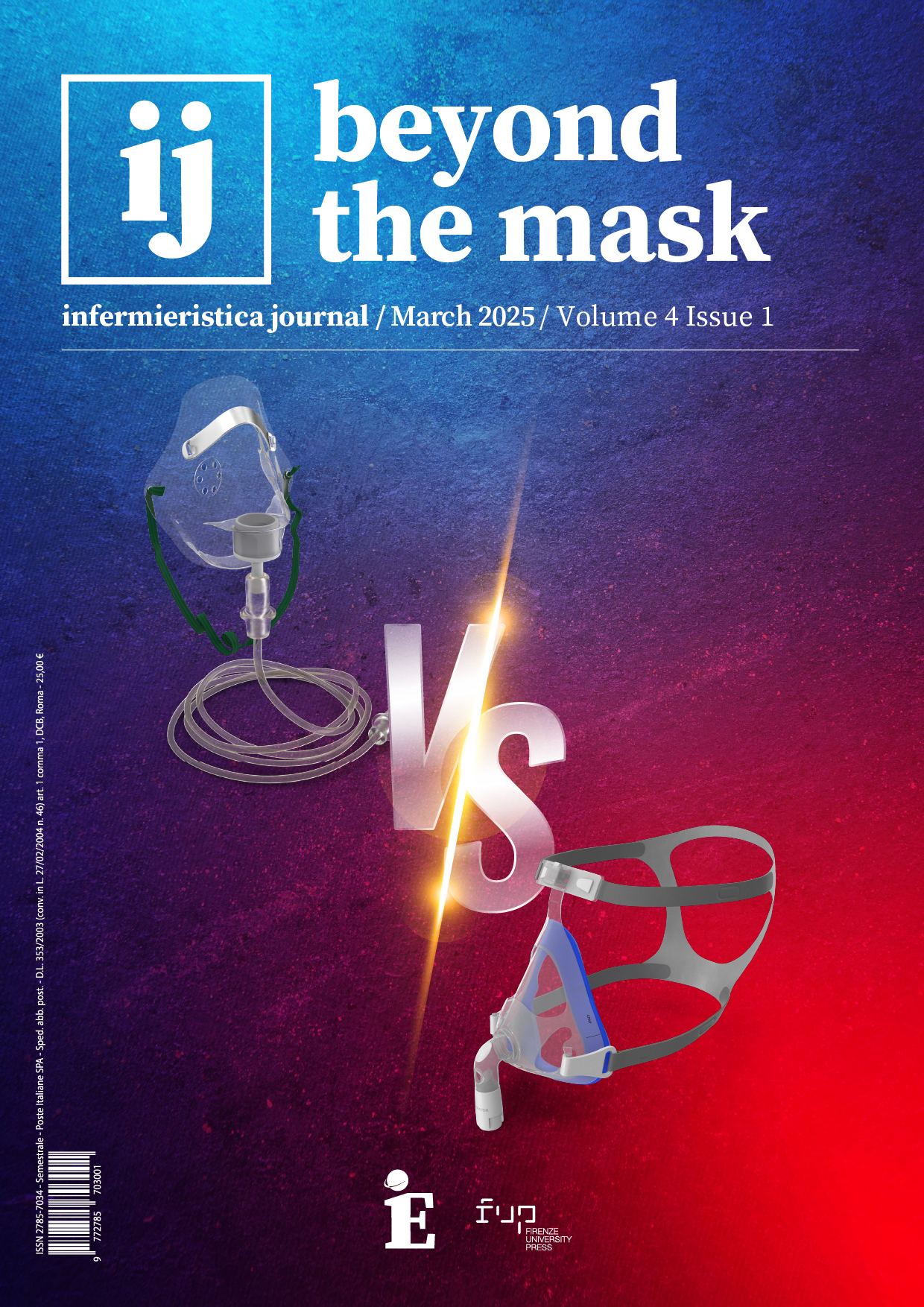Published 2025-03-31
Keywords
- Breast Self-Examination,
- Breast Cancer,
- Health Belief Model,
- Women,
- Prevention
Copyright (c) 2025 Elena Stefanelli, Sofia Colaceci, Giancarlo Marcheggiani, Ramacciati Nicola

This work is licensed under a Creative Commons Attribution 4.0 International License.
Abstract
Introduction. Breast cancer is a significant global health issue. In Italy, it represents 30.3% of female cancer cases. Early detection through mammography is crucial, particularly for women who face a higher risk. Moreover, breast self-examination (BSE) is a tool that can help women become familiar with their breasts to identify breast changes and contact their physicians for clinical assessments. We conducted a study with an observational–descriptive survey design. The objective was to examine women’s knowledge, beliefs and practices about breast cancer prevention and BSE.
Methods. Data collection relied upon the Italian-validated version of the Champion’s Health Belief Model Scale, consisting of 31 items related to susceptibility, gravity, perceived benefits, perceived barriers and self-efficacy. The inclusion criteria required the women to be between 20 and 44 years of age and to be living in Umbria, Italy. The convenience sample was stratified according to the age distribution of women.
Results. A total of 252 questionnaires were collected. After screening for completeness and ensuring they met the required criteria, the final sample included 150 women according to the predetermined stratification. Most women had a university education (53.3%); about 44% were mothers, 75.7% of whom had breastfed. Most practiced BSE (73.3%), with no significant sociodemographic differences. Educational levels impacted perceived breast cancer risk, with 21.4% of lower-educated women fearing higher susceptibility (p=0.049). Self-efficacy was higher amongst self-examiners, but uncertainty was prevalent in both groups. Embarrassment and time constraints were barriers, but other Health Belief Model variables exhibited no significant differences between BSE and non-BSE groups.
Discussion and Conclusion. This study uncovered a strong link between women’s self-efficacy, confidence in performing a BSE and BSE practice. Education and health campaigns should consider socio-demographic factors (e.g. level of education, age) to promote BSE, especially amongst women who are not covered by mammography screenings.
References
- Sung H, Ferlay J, Siegel RL, et al. Global cancer statistics 2020: GLOBOCAN estimates of incidence and mortality worldwide for 36 cancers in 185 countries. CA Cancer J Clin. 2021;71(3):209-249. doi:10.3322/caac.21660
- AIOM, AIRTUM, Fondazione AIOM, ONS, PASSI, PASSI d’Argento, SIAPeC-IAP. I numeri del cancro in Italia 2022. Brescia: Intermedia Editore; 2022.
- Ghoncheh M, Pournamdar Z, Salehiniya H. Incidence and mortality and epidemiology of breast cancer in the world. Asian Pac J Cancer Prev. 2016;17(S3):43-46. doi:10.7314/apjcp.2016.17.s3.43
- Associazione Italiana di Oncologia Medica (AIOM). Linee guida Neoplasie della mammella. 2020.
- Johnson RH, Anders CK, Litton JK, Ruddy KJ, Bleyer A. Breast cancer in adolescents and young adults. Pediatr Blood Cancer. 2018;65(12):e27397. doi:10.1002/pbc.27397
- Shoemaker ML, White MC, Wu M, Weir HK, Romieu I. Differences in breast cancer incidence among young women aged 20-49 years by stage and tumor characteristics, age, race, and ethnicity, 2004–2013. Breast Cancer Res Treat. 2018;169(3):595-606. doi:10.1007/s10549-018-4699-9
- Tomao F, Miele E, Barberi S, et al. Carcinoma mammario giovanile [Breast carcinoma in young women]. Recenti Prog Med. 2006;97(4):225-228.
- Coleman C. Early detection and screening for breast cancer. Semin Oncol Nurs. 2017;33(2):141-155. doi:10.1016/j.soncn.2017.02.009
- Kösters JP, Gøtzsche PC. Regular self-examination or clinical examination for early detection of breast cancer. Cochrane Database Syst Rev. 2003;2003(2):CD003373. doi:10.1002/14651858.CD003373
- Kolak A, Kamińska M, Sygit K, et al. Primary and secondary prevention of breast cancer. Ann Agric Environ Med. 2017;24(4):549-553. doi:10.26444/aaem/75943
- Conte L, De Nunzio G, Lupo R, et al. Breast cancer prevention: the key role of population screening, breast self-examination (BSE) and technological tools. Survey of Italian women. J Cancer Educ. 2023;38(5):1728-1742. doi:10.1007/s13187-023-02327-3
- Manna A, Piacentini EO. La prevenzione del tumore al seno: uno studio preliminare su un campione di donne italiane. NSC Nurs. 2020;4(2):24-38. doi:10.32549/OPI-NSC-41
- Rosenstock IM. Why people use health services. Milbank Mem Fund Q. 1966;44(3 Suppl):94-127.
- Carpenter CJ. A meta-analysis of the effectiveness of health belief model variables in predicting behavior. Health Commun. 2010;25(8):661-669. doi:10.1080/10410236.2010.521906
- Champion VL. Use of the health belief model in determining frequency of breast self-examination. Res Nurs Health. 1985;8(4):373-379. doi:10.1002/nur.4770080410
- Champion VL. The relationship of breast self-examination to health belief model variables. Res Nurs Health. 1987;10(6):375-382. doi:10.1002/nur.4770100605
- Avci IA. Factors associated with breast self-examination practices and belief in female workers at a Muslim community. Eur J Oncol Nurs. 2008;12(2):127-133. doi:10.1016/j.ejon.2007.11.006
- Secginli S, Nahcivan NO. Factors associated with breast cancer screening behaviours in a sample of Turkish women: a questionnaire survey. Int J Nurs Stud. 2006;43:161-171. doi:10.1016/j.ijnurstu.2005.02.004
- Guliford K, McKinley E, Turner L. Breast cancer knowledge, beliefs, and screening behaviors of college women: application of the health belief model. Am J Health Educ. 2017;48(4):256-263. doi:10.1080/19325037.2017.1316694
- Erbil N, Bölükbaş N. Beliefs, attitudes, and behavior of Turkish women about breast cancer and breast self-examination according to a Turkish version of the Champion Health Belief Model Scale. Asian Pac J Cancer Prev. 2012;13(11):5823-5828.
- Harris AJ, Hahn U. Unrealistic optimism about future life events: a cautionary note. Psychol Rev. 2011;118(1):135-154. doi:10.1037/a0020997
- Abolfotouh MA, BaniMustafa AA, Mahfouz AA, Al-Assiri MH, Al-Juhani AF, Alaskar AS. Using the health belief model to predict breast self-examination among Saudi women. BMC Public Health. 2015;15:1163. doi:10.1186/s12889-015-2510-y
- Dewi TK, Massar K, Ruiter RAC, Leonardi T. Determinants of breast self-examination practice among women in Surabaya, Indonesia: an application of the health belief model. BMC Public Health. 2019;19(1):1581. doi:10.1186/s12889-019-7951-2
- Sharaa HM. Beliefs and reported practices related to breast self-examination among sample of Egyptian women. Acad J Cancer Res. 2013;6(2):99-110. doi:10.5829/idosi.ajcr.2013.6.2.71207
- Gaballah I. Awareness, knowledge and practice of breast self-examination among Saudi women. Med J Cairo Univ. 2011;79(2):81-86.
- Tastan S, Iyigün E, Kılıc A, Unver V. Health beliefs concerning breast self-examination of nurses in Turkey. Asian Nurs Res (Korean Soc Nurs Sci). 2011;5(3):151-156. doi:10.1016/j.anr.2011.09.001


